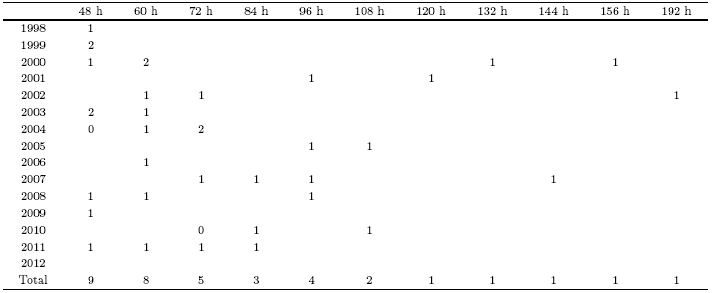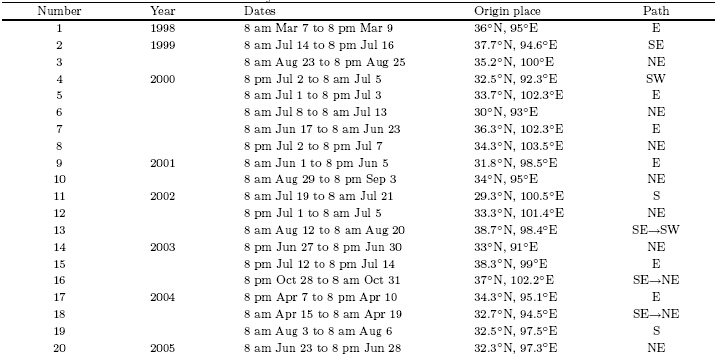The Chinese Meteorological Society
Article Information
- YU Shuhua, GAO Wenliang, PENG Jun, XIAO Yuhua. 2014.
- Observational Facts of Sustained Departure Plateau Vortexes
- J. Meteor. Res., 28(2): 296-307
- http://dx.doi.org/10.1007/s13351-014-3023-9
Article History
- Received April 15, 2013;
- in final form November 6, 2013
2 Yaan City Meteorological Bureau, CMA, Yaan 625000;
3 Sichuan Provincial Meteorological Observatory, CMA, Chengdu 610072
The Tibetan Plateau, the highest and most com-plex topography in the world, plays an important rolein the weather and climate of China. It is not onlythe source of convective cloud clusters, which may in-duce severe rainstorms over the Yangtze River basin and Jianghuai area(Tao and Ding, 1981; Ding, 1993; Zhang et al., 2001), but also the seedbed of some par-ticular synoptic systems, such as the plateau vortex(PV), the plateau shear line, the plateau trough, and so on.
Vortexes often emerge over the Tibetan Plateauin summer. Some of them, especially the sustainedones, move off the plateau domain, and often causedisastrous weather to the east of the plateau(Yu et al., 2007a). The PV has drawn many meteorologists'attention for years. Progress has been made since theresearch by the "Plateau Meteorology Scientific Re-search Working Group" in 1972 as well as the "FirstTibetan Plateau Scientific Experiment". The leadingChinese meteorologists Ye and Gao(1979)pointed outthat the shallow synoptic systems on scales of about500 km in horizontal and 2-3 km in vertical inside theplateau boundary layer, are likely to develop and sus-tain themselves enough to move out of the plateau un-der appropriate circumstance. A number of previousstudies(Lhasa Research Group on Tibetan Plateau Meteorology, 1981; Qian et al., 1984; Research Groupon the Tibetan Plateau, 1987; Sun, 1987; Kuo et al., 1988; Zhang et al., 1988; Luo, 1992; Ding, 1993; Luo et al., 1993; Qiao and Zhang, 1994)have found outthe source, activity pattern, generation factor, and structure of the PV, as well as the related topographicinfluence. Chen et al. (2000)pointed out that thelarge-scale terrain could impact the movement of avortex. As indicated by Li(2002), migration of theTibetan Plateau vortex(TPV)out of the source re-gion occurred under the effect of some steering flows. Song and Qian(2002)found that the average air thick-ness in the east or center of the plateau could hint themovement of the plateau vortex. The TPV has beenfurther studied since the Second Tibetan Plateau Sci-entific Experiment. A number of researchers have in-vestigated the departure plateau vortex(Wang, 1987; Wang and Orlanski, 1987; Gao, 1998; Tao et al., 1999; Chang et al., 2000; Yu and He, 2001; Cheng and Feng, 2002; Yu, 2002; Takahashi, 2003; Li and Xu, 2005). Inrecent years, the large-scale environment of the vortexdeparting the plateau and the mechanism of the vor-tex's eastward movement have been further revealed(Yu and Gao, 2006, 2008, 2009, 2010; Yu et al., 2007a, b, 2008, 2012; He et al, 2009a, b; Jiang et al., 2009; Wang et al., 2009; Chen and Li, 2011; Li et al., 2011; Wu et al., 2013; Zheng et al., 2013). However, researchon the sustained departure plateau vortex(SDPV)isstill missing.
The main contribution of this paper is to revealthe main characteristics and influences of the SDPVon the weather of China. We expect that this studywill be helpful to better underst and the SDPV move-ment and its impact on persistent intense rainfall ineastern China, and thus provide a further basis forthe related disastrous weather forecasting in the fu-ture. Here, "sustained" means that the life cycle of adeparture vortex is more than 2 days. 2. Data and methodology2.1 Data
Four datasets are used in this paper. The firstone includes geopotential height, temperature, winddirection, and wind speed at 500 hPa, based on the120 radiosonde station observations twice a day from1998 to 2012(Fig. 1). The second one is the 24-h cu-mulated rainfall data collected from the 1244 nationalmeteorological stations from 1998 to 2012, with qual-ity control by the National Meteorological Informa-tion Center of China Meteorological Administration(CMA). The third one refers to the year book of theplateau vortex and shear line from 1998 to 2011, pub-lished by the Chengdu Institute of Plateau Meteorol-ogy of CMA. The fourth dataset is the Tropical Rain-fall Measure Mission(TRMM)data, from the God-dard Earth Science Data and Information ServicesCenter, National Aeronautics and Space Administra-tion(NASA)of the United States of America.
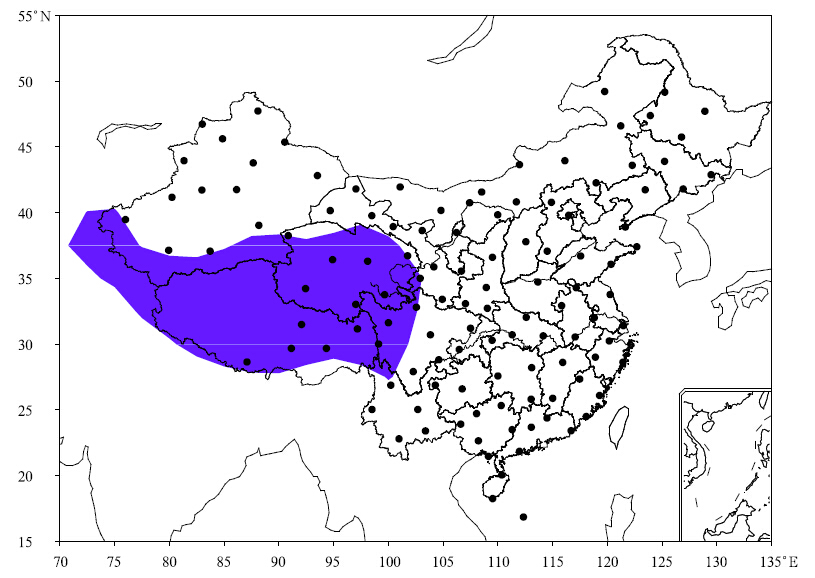 |
| Fig. 1. Distribution of China radiosonde stations. The shaded area is the region with altitude higher than 2500 m. |
With the synoptic analysis and statistical anal-ysis methods, different processes of sustained TPVsthat last for 2 days or more outside the plateau regionare investigated and analyzed in this paper.
First, an SDPV is demarcated as a low pressuresystem with closed isoheight or a vortex with cyclonicwinds in three adjacent stations at 500 hPa, gener-ated over the Tibetan Plateau, with a more than 2-day lifetime after departing the plateau. By contrast, a UDPV is a departure plateau vortex with a life cycleof less than 2 days.
Second, the plateau vortexes are sorted into threegroups according to the SDPV activity: the warm, the cold, and the baroclinic, based on the tempera-ture distribution of the vortex at the 500-hPa synop-tic map. If a vortex is situated in the warm spine at500 hPa without clod air incursion, it is categorizedas the warm PV. However, a vortex is categorized asbaroclinic if it is swarmed into the cold air obviously, in spite of its location in the warm trough or in thefrontal zone. The cold, of course, indicates that thevortex exists in the cold environment entirely.
Third, the rainy area of an SDPV is determinedby both the vortex circumfluence range at 500 hPa and the observed rainfall distribution, including therainfall incurred by both synoptic systems and TPVswhich are hard to distinguish. A sustained regionalrainstorm is identified according to the rainfall at thestations within an area of 2°× 2° longitude/latitudewhere the rain occurs for 3 continuous days and thecumulated rainfall is at least equal to or more than150 mm.
Finally, based on the definitions above, all theSDPVs that occurred during 1998-2012 are identified and studied.
The paper is organized as follows. The SDPVswere analyzed in terms of their active year and month, their path and seedbed in Section 3. Section 4. 1presents the variations of the SDPV intensity and re-lated precipitation. The relationship between SDPVs and sustained regional rainstorms is probed in Sec-tion 4. 2. The impact of underlying surface on theSDPV and subsequent rainfall is exainined in Section4. 3. Section 4. 4 discusses the synoptic system relatedto SDPVs. The differences between SPDVs and UD-PVs are compared in detail in Section 5. Lastly, theconclusions are given in Section 6. 3. Activity of SDPVs over 1998-2012
The frequency, origin, and path of SDPVs during1998-2012 are analyzed in detail here. 3.1 Frequency
Table 1 shows the numbers of SDPVs in each year and each month over 1998-2012. As shown, year 2000tops in number, with a total of 5, and the next is year2007, with a total of 4, which may be related to thefloods in northern China and the Yellow River at thetime. The least is in year 2012, none appears. Thevariation of the frequency of SDPVs is different fromthat of the UDPVs(Yu and Gao, 2006). During 1998-2012, the earliest SDPV emerged in the first 10 days ofMarch, while the latest appeared near the end of Oc-tober. SDPVs were relatively frequent in June, July, and August with the most in July and the least inAugust, unlike UDPVs with less difference in their oc-currence frequency among the three months(Yu and Gao, 2006).
Figure 2 shows the starting places of SDPVs fromthe 15-yr statistics. The shading in Fig. 2 repre-sents the Tibetan Plateau. The serial numbers of SD-PVs are marked. The circle implies that two or moreSDPVs have occurred within the enclosed area. Ob-viously, most SDPVs form in the eastern portion ofthe Tibetan Plateau, especially in Qumalai, Zhaduo, Yushu, Aba, Kangding, Tuole, and Huangyuan, in-stead of in Dege as for the UDPVs(Yu and Gao, 2006). This is also different from the frequency distributionof PVs(Sun, 1987); the PVs unable to leave theplateau occur largely in Qiangtang, Naqu, Caidamu, and Songpan.
 |
| Fig. 2. The starting places of SDPVs. The sequence numbers indicate the movement order of the sustained plateauvortex and the circles indicate the regions with concentrated occurrence(two or more)of the plateau vortexes. |
The starting places of those SDPVs concentratein the eastern part of the plateau. This is possibly be-cause the radiosonde stations in the western plateauare rare and the related data are lacking. Therefore, it is diflcult to verify whether the SDPVs can alsooriginate from the western part of the plateau or not. 3.3 Path
Statistical data show that three-fouths of SDPVsin the 15-yr period moved to north of the YangtzeRiver(figure omitted). Table 2 shows that most SD-PVs moved eastward or northeastward, some south-ward or southeastward first and then turned to northeast, with a few swerving from northeast to southeastor from southeast to southwest, much more complexcompared to the path of UDPVs. This may be theconsequence of SDPVs being influenced by differentsynoptic weather systems while they moved eastward.
 | ||||||||
| Note: numbers indicate occurrence times of a certain path; capital letters denote path direction, e. g., NE means northeastward. The short line between two capital letters such as NE-SE signifies a veer. | ||||||||
Generally, the SDPVs shifted eastward or north-eastward in June, eastward or southward in July, northeastward or southward in August, similar to UD-PVs for June but dissimilar for July and August(Yu and Gao, 2006). 3.4 Lifetime of SDPVs
Table 3 lists the lifetime of all SDPVs in each year and each month from 1998 to 2012. It is shown that61% of the SDPVs survived for 48-72 h, a few lived to108 h, only five over 120 h, and one even up to 192 h.
The above facts indicate that SDPVs are differ-ent in many aspects, such as their frequency, origin, and path. Next, we examine the variability of SDPVsin their intensity and related precipitation as well astheir interaction with other synoptic weather systems. 4.1 Variations of SDPVs during their lifetime
The thermodynamical characteristics of SDPVsin the 15-yr period at the beginning of departure and by end of their lifetime are listed in Table 4. The re-sults are as follows. (1)The lifetime of an SDPV is tosome extent related to its thermodynamical propertyat the beginning of departure. The SDPVs, with alifetime of 48 h are often of baroclinic nature at thebeginning of departure; those surviving for longer than60 h are either baroclinic or cold at the beginning ofdeparture. (2)The thermodynamical property of theSDPVs usually change with time. By the end of theirlifetime, 82% of the SDPVs with 48-h lifetime are baro-clinic, while other 18% are warm; 83% of the SDPVswith 60- and 72-96-h lifetime present baroclinity, and others are instead cold. In addition, all SDPVs over108 h are baroclinic. (3)Most SDPVs experience low-ered geopotential height by the end of their lifetimecompared to at the beginning of departure, especiallyfor those longer than 72 h. (4)About 66% of the SD-PVs possess increased wind speed at the vortex cen-ter and nearly 17% remain unchanged. Those SDPVslasting over 108 h all have increased center wind speed.
 | |||||||||
| Note: W denotes warm, and C denotes cold. | |||||||||
As shown above, the SDPVs change their ther-modynamical property and intensity after departure. Those that survive for more than 48 h are usually baro-clinic. The longer the duration, the more the baroclin-ity. There is no warm vortex after 60 h. In terms ofthe thermodynamical property at the beginning of de-parture, 20% of all SDPVs are warm while 56% of allUDPVs are warm(Yu et al., 2008). This suggests thatthe SDPVs lasting over 2 days involve more active coldair than the UDPVs. Cold air might strengthen thebaroclinity of a vortex, transform eflcacious potentialenergy to kinetic energy, and thereby refresh the SD-PVs.
Unlike the UDPVs that weaken rapidly due toincrease of geopotential height and reduction of windspeed at the center of the vortex(Yu and Gao, 2006), the SDPVs become strengthened due to the decreaseof geopotential height and increase of vortex centerwind speed; some keep unchanged. All the SDPVswith lifetime longer than 72 h experience a declinein geopotential height, and all those surviving longerthan 108 h possess increased center wind. In otherwords, the decrease of geopotential height and increaseof vortex center wind speed contribute positively tothe duration of SDPVs to the east of the plateau. 4.2 Variation of precipitation intensity following the SDPVs
Table 5 displays the percentages of the SDPVswith rainfalls at different intensity grades and theirvariations. As summarized in the table, precipitationis strengthened no matter how long the SDPVs sus-tain. In general, SDPVs give rise to rainfalls at leastat the grade of heavy rain(30-49 mm), more often toeven downpours. When an SDPV survives longer than72 h, there is a 90% possibility that extremely heavyrain or downpour will happen.
 | |||||||
| The percentage values in the table represent the proportion of the SDPVs that induce certain intensity rainfall. | |||||||
Analysis of the SDPV and related sustained re-gional rainstorm reveals that 44% of the SDPVs couldlead to sustained regional rainstorm in China, mainlyin Guizhou, Chongqing, and Shanxi, sometimes evenin Gansu, Henan, Jiangxi, Hubei, Yunnan, Guangxi, Guangdong, and Hainan(table omitted).
As shown, the SDPVs with lifetime longer thanthree days usually incur heavy or extremely heavyrain. The SDPVs are one of most important factorsinducing sustained regional rainstorms in China, espe-cially to the south of the Yellow River. 4.3 Variation of SDPVs moving into the sea
The statistics shows that 7 SDPVs moved all theway into the adjacent seas in the 15-yr period(Table 6). Four SDPVs moved into the Yellow Sea, two intothe Bohai Sea, and one into the Japan Sea. In terms ofmonthly variation, two SDPVs occurred in April and moved into the Yellow Sea, two in June and July intothe Bohai Sea and Yellow Sea separately, and one inAugust into the Japan Sea(Fig. 3).
 | ||||||||||
| △(24 h)is the daily geopotential height change at 500 hPa calculated at the time of the vortex entering into the sea. Thesupscript "hour" in columns 8 or 20 denotes Beijing time. | ||||||||||
 |
| Fig. 3. Tracks of the SDPVs moving into the sea. The shading is the same as in Fig. 1. |
Comparative analysis of geopotential height of theseven SDPVs moving into the sea reveals that six ofthem enhance as geopotential height has decreased. Usually, geiopotential height decreases by 2-3 dgpmduring 24 h. The maximum decrease of 6 dgpm hap-pened during 0800 BT(Beijing Time)15-0800 BT 19April 2004, and the related SDPV finally moved intothe Yellow Sea.
Based on the TRMM rainfall data, all of theseven SDPVs that later moved into the sea occurredwith higher precipitation intensity. The hourly rain-fall could increase by 1-9 mm h-1. The maximumaugment appeared during 0800 BT 1-2000 BT 5 June2001 when the SDPV shifted to the Yellow Sea. Beforemoving into sea, the vortex produced rainfall at 6. 12mm h-1; after 2000 BT, when the vortex was over thesea, rainfall rate rose to 15. 12 mm h-1, an increase of9 mm h-1.
Thus, a plateau vortex could be strengthened af-ter moving into the sea, as reflected in the droppinggeopotential height and enhanced rainfall. It behavesdifferently compared to a l and falling tropical cyclone. 4.4 Variation of the SDPV path by certain synoptic systems
The synoptic analysis reveals that two-thirds ofthe SDPVs in the 15-yr period move in sheared sur-roundings; 54% of them go eastward, and 20% of themgo southward. The leading synoptic systems for theSDPVs are much diverse compared to those for theUDPVs. Definitely, 33% of the SDPVs follow a nor-thern high-pressure ridge, 13% after the shear lineon the tip of a trough, 8% along a shear line, 28% in thewake of northern or northeastern trough. The last 28%SDPVs even go northeastward following the trough, orgo southeastward owing to the southeastward stretchof the trough. A minor few of SDPVs go eastward firstwith a trough and then within sheared environment, or on the contrary, with a shear line first. In short, theSDPVs to the east of the plateau act differently com-pared to the PVs over the the plateau as most of thelatter go eastward along within sheared environment(Lhasa Research Group on Tibetan Plateau Meteorol-ogy, 1981). The SDPVs are also somewhat differentfrom the UDPVs, nearly half of which shift eastwardalong the trough to its north or east(Yu and Gao, 2006).
We found that 4 of the SDPVs in the 15-yr periodonce recurved and turned around over the bend of theYellow River. They all took place in sheared environ-ments and were accompanied with a remote tropicallow pressure over the sea. The low pressure systemseemed to have blocked the SDPVs to go forward(Fig. 4).
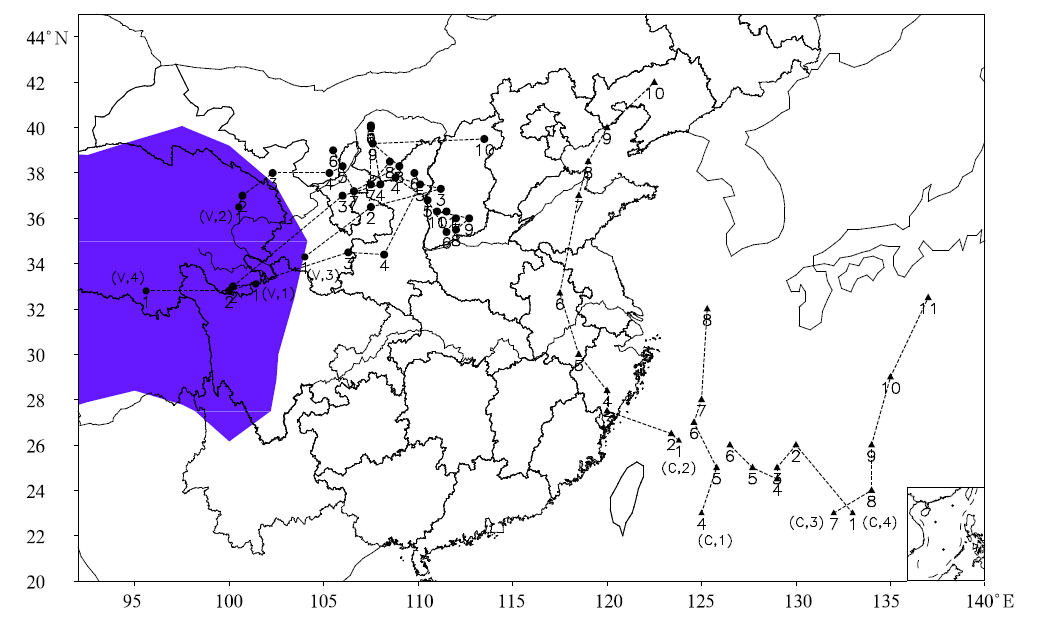 |
| Fig. 4. The active tracks of the recurving SDPVs(the label "V" denotes SDPV, while "C" denotes tropical lowpressure) and the corresponding tropical low pressure systems. The shading is the same as in Fig. 1. |
We also found that three SDPVs moved oppo-sitely to the l and ed tropical low pressure originatedfrom the sea to the east of Taiwan or the South ChinaSea, with two of them surviving in sheared environ-ments, the other surrounded by a trough to the north and a vortex to the south(Fig. 5).
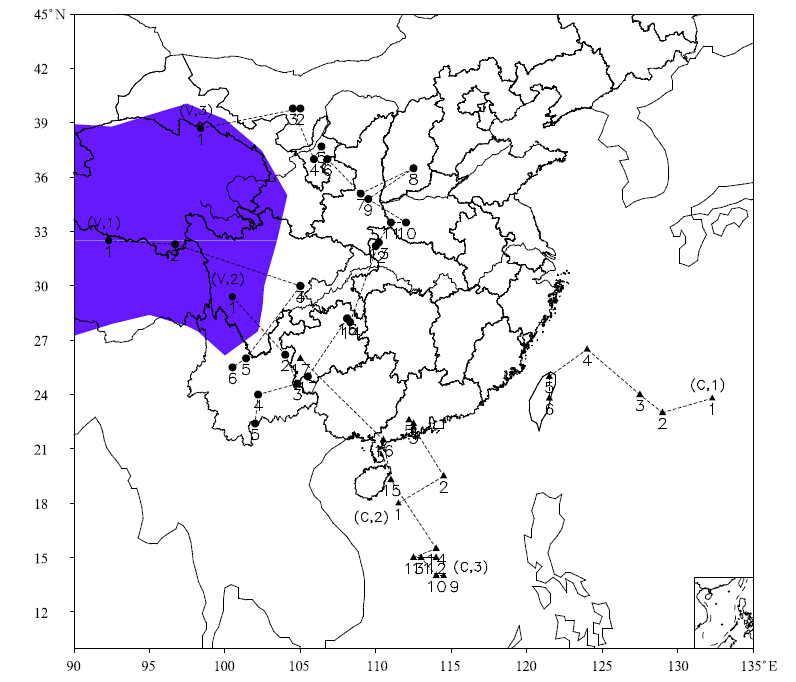 |
| Fig. 5. The active tracks of three SDPVs moving oppositely with three tropical low pressure systems. The shading isthe same as in Fig. 1. |
Two SDPVs are even found to move southwardinto Vietnam. In the two cases, the subtropicalhigh extended more southward or northward, and thesheared wind field formed in between the Qinghai-Xizang high and the subtropical high, which led thevortexes all the way to the south. 5. Comparison on the characteristics of SDPVs and UDPVs
Table 7 compares the characteristics of SDPVs and UDPVs in different aspects, such as frequency, source, path, thermadynamic property, leading syn-optic system, and path alteration. It is interesting tonote that with the presence of a tropical low pressuresystem, SDPVs have a higher chance to recurve overthe bend of the Yellow River.
(1)The SDPVs are dynamically active from Juneto August with most occurrences in July, while theUDPVs happen with almost the same occurrence frequency within the three summer months. It is foundthat Qumalai is the starting place of most SDPVs.
(2)The SDPVs are largely active to the north ofthe Yangtze River; most of them move eastward ornortheastward and situated in the sheared surround-ings, while the UDPVs shift eastward or southeast-ward following a trough.
(3)The SDPVs are one of the most importantfactors that lead to sustained regional rainstorms inChina, especially to the south of the Yellow River. TheSDPVs' impact may reach a much wider area; theymay even affect the weather in the Korean Peninsula, Japan, and Vietnam.
(4)An SDPV alerts its intensity and thermody-namic property during its movement. Most of the SD-PVs are baroclinic or cold, leading to rainstorms orsustained regional rainstorms.
(5)Some SDPVs may move into the sea and get strengthened with enhanced rainfall and declinedgeopotential height.
(6)The SDPVs might spin over the bend of theYellow River as a result of the influence of the re-mote tropical cyclonic activity. It could move in theopposite direction to the l and ed tropical low pressuresystem originated over the sea to the east of Taiwanor the South China Sea.
Acknowledgments: The precipitation and at-mospheric observation data are provided by Mr. XiaoDixiang. Thanks to Dr. Yu Chen for helping with thetranslation of the paper.
| Chang, C. P., L. Yi, and G. T. Chen, 2000: A numerical simulation of vortex development during the 1992 East Asian summer monsoon onset using the Navy's regional model. Mon. Wea. Rev., 128, 1604-1631. |
| Chen Gong and Li Guoping, 2011: Characteristics of the tangential flow field of the Tibetan Plateau vortices and associated waves. Acta Meteor. Sinica, 69, 956-963. (in Chinese) |
| Chen Lianshou, Ma Jingxian, and Luo Zhexian, 2000: A preliminary study on the vortex movement over the orography. The Second Theoretic Research Advance of Tibetan Plateau Atmosphere III. China Meteorology Press, 90-97. (in Chinese) |
| Cheng Linsheng and Feng Wuhu, 2002: A number of advances in the research on midlatitude mesoscale convective systems. Plateau Meteor., 21, 337-347. (in Chinese) |
| Ding Yihui, 1993: The Research of Severe Heavy Rain- fall Storms in the Jiang-Huai River Valley in 1991. China Meteorological Press, 113-128. (in Chinese) |
| Gao Shouting, 1998: Review on the mesoscale dynamic research under the guidance of Shiyan Tao. The East Asian Monsoon and Heavy Rain Storms in China. Institute of Atmospheric Physics, Chinese Academy of Sciences, Ed., China Meteorological Press, 150- 156. (in Chinese) |
| He Guangbi, Gao Wenliang, and Tu Nini, 2009a: Dynamic diagnosis on two Tibetan Plateau vortexes: Their easterward movement and developing mechanism. Acta Meteor. Sinica, 67, 599-612. (in Chinese) |
| He Guangbi, Gao Wenliang, and Tu Nini, 2009b: Observational analysis of the shear line and low vortex over the Tibetan Plateau in summer from 2000 to 2007. Plateau Meteor., 28, 549-555. (in Chinese) |
| Jiang Yanrong, He Jinhai, Wen Min, et al., 2009: Characteristics of the vortexes on the east side of the Tibetan Plateau from winter to spring and their impact on the weather and climate in China. Plateau Meteor., 28, 945-954. (in Chinese) |
| Kuo, Y. H., L. S. Cheng, and J. W. Bao, 1988: Numer- ical simulation of the 1981 Sichuan flood. Part I: Evolution of a mesoscale southwest vortex. Mon. Wea. Rev., 116, 2481-2504. |
| Lhasa Research Group on Tibetan Plateau Meteorology, 1981: The 500-hPa of Vortex and Shear Line over the Tibetan Plateau in Summer. Science Press, 1- 122. (in Chinese) |
| Li Guoping, 2002: Dynamic Meteorological Study of the Tibetan Plateau. China Meteorological Press, 22-23. (in Chinese) |
| Li Guoping, and Xu Qi, 2005: Effect of dynamic pumping in the boundary layer on the Tibetan Plateau vortices. Chinese J. Atmos. Sci., 29, 965-972. (in Chinese) |
| Li Guoping, Luo Xiping, Chen Ting, et al., 2011: Preliminary theoretical study of waves in the Tibetan Plateau vortex. Plateau Meteor., 30, 553-558. (in Chinese) |
| Luo Siwei, 1992: The Research of Several Synoptic Sys- tems over the Tibetan Plateau and Nearby Areas. China Meteorological Press, 1-52. (in Chinese) |
| Luo Siwei, He Meilen, and Lu Xiaodong, 1993: The study on the lows over the Qinghai-Tibetan Plateau in summer. Science China (Ser. B), 23, 778-784. Chinese) |
| Qian Zhengan, Shan Fuming, Nu Junling, et al., 1984: The discussion on climate factors and statistical analysis of the Tibetan Plateau vortex in summer 1979. The Tibetan Plateau Meteorological Experiment Corpus II. Science Press, 182-194. (in Chinese) |
| Qiao Quanming and Zhang Yagao, 1994: Tibetan Plateau Synoptics. China Meteorological Press, 120-190. (in Chinese) |
| Research Group on the Tibetan Plateau Weather, 1987: The Influences of the Tibetan Plateau on Summer Weather of China. Science Press, 1-97. (in Chinese) |
| Song Minhong and Qian Zhengan, 2002: Impact of plateau and cold air on the western Pacific subtropical high and summer rain belt in 1998 and 1991. Plateau Meteor., 21, 556-564. (in Chinese) |
| Sun Guowu, 1987: The applications in weather forecast of Tibetan Plateau meteorological researches. The Influence of Tibetan Plateau on China in Summer. Science Press, 1-11. (in Chinese) |
| Takahashi, H., 2003: Observational study on the initial formation process of the Mei-yu frontal disturbance in the eastern foot of the Tibetan Plateau in middlelate June 1992. J. Meteor. Soc. Japan, 81, 1303- 1327. |
| Tao, S. Y., and Y. H. Ding, 1981: Observational evidence of the influence of the Qinghai-Xizang (Tibet) Plateau on the occurrence of heavy rain and severe convective storms in China. Bull. Amer. Meteor. Soc., 62, 23-30. |
| Tao, S. Y., Chen Lianshou, Xu Xiangde, et al., 1999: The Sec- ond Theoretic Research Advance of Tibetan Plateau Atmosphere I. China Meteorological Press, 274-281. (in Chinese) |
| Wang, B., 1987: The development mechanism for Ti- betan Plateau warm vortices. J. Atmos. Sci., 44, 2978-2994. |
| Wang, B., and I. Orlanski, 1987: Study of a heavy rain vortex formed over the eastern flank of the Tibetan Plateau. Mon. Wea. Rev., 115, 1370-1393. |
| Wang Xin, Li Yueqing, Yu Shuhua, et al., 2009: Sta- tistical study on the plateau low vortex activities. Plateau Meteor., 28, 64-71. (in Chinese) |
| Wu Guoxiong, Zheng Yongjun, and Liu Yimin, 2013: Dynamical and thermal problems in vortex development and movement. Part II: Generalized slantwise vorticity development. Acta Meteor. Sinica, 27, 15-25. |
| Ye Duzheng and Gao Youxi, 1979: The Tibetan Plateau Meteorology. Science Press, 122-126, 145-146, 259- 260. (in Chinese) |
| Yu Shuhua, 2002: Water vapor imagery of vortex moving process over the Qinghai-Tibetan Plateau. Plateau Meteor., 21, 199-204. (in Chinese) |
| Yu Shuhua and Gao Wenliang, 2006: Observational analysis on the movement of vortices before/after moving out of the Tibetan Plateau. Acta Meteor. Sinica, 64, 392-399. (in Chinese) |
| Yu Shuhua, Gao Wenliang, and Gu Qingyuan, 2007a: The middle-upper troposphere general circulation characteristics of the Plateau Vortex that induced flood in China in recent years. Plateau Meteor., 26, 466-475. (in Chinese) |
| Yu Shuhua, Gao Wenliang, and Xiao Yuhua, 2008: Diagnostic analysis of the cold air influences on the plateau Vortex moving out of the Tibetan Plateau-A comparative case study. Plateau Meteor., 26, 96-103. (in Chinese) |
| Yu Shuhua and Gao Wenliang, 2008: The large-scale conditions of the vortex moving out of the Qinghai-Tibetan Plateau. Plateau Meteor., 27, 1276-1287. (in Chinese) |
| Yu Shuhua and Gao Wenliang, 2009: Largescale conditions of Tibetan Plateau vortex departure. Sciences in Cold and Arid Regions, 1, 559-569. |
| Yu Shuhua and Gao Wenliang, 2010: Comparison of structure characteristics between two Tibetan Plateau vortexes in summer 1998. Plateau Meteor., 29, 1357-1368. (in Chinese) |
| Yu Shuhua, Gao Wenliang, and Peng Jun, 2012: Statistical analysis of Qinghai-Tibetan Plateau vortex movements influencing rainfall in China. Plateau Meteor., 31, 592- 604. (in Chinese) |
| Yu Shuhua and He Guangbi, 2001: Numerical study of influences of water vapor in the middle and upper troposphere on the formation of vortex over the Tibetan Plateau. J. Nanjing Inst. Meteor., 24, 553-559. (in Chinese) |
| Yu Shuhua, Xiao Yuhua, and Gao Wenliang, 2007b: Cold air influences on the Tibetan Plateau vortex moving out of the plateau. J. Appl. Meteor. Sci., 18, 737-747. (in Chinese) |
| Zhang Jijia, Zhu Baozheng, and Zhu Feikong, 1988: Advances in Tibetan Plateau Meteorology. Science Press, 4-12, 168-192. (in Chinese) |
| Zhang Shunli, Tao Shiyan, Zhang Qingyun, et al., 2001: Meteorological and hydrological characteristics of severe flooding in China during the summer of 1998. J. Appl. Meteor. Sci., 12, 442-457. (in Chinese) |
| Zheng Yongjun, Wu Guoxiong, and Liu Yimin, 2013: Dynamical and thermal problems in vortex development and movement. Part I: A PV-Q view. Acta Meteor. Sinica, 27, 1-14. |
 2014, Vol. 28
2014, Vol. 28




